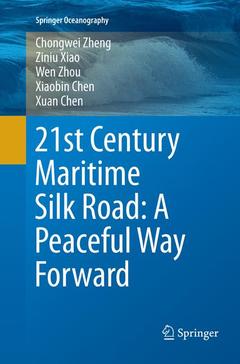Description
21st Century Maritime Silk Road: A Peaceful Way Forward, Softcover reprint of the original 1st ed. 2018
Springer Oceanography Series
Language: English
Subjects for 21st Century Maritime Silk Road: A Peaceful Way Forward:
Publication date: 01-2019
Support: Print on demand
Publication date: 05-2018
Support: Print on demand
Description
/li>Contents
/li>Biography
/li>Comment
/li>
This book focuses on understanding the characteristics of the marine environment; overall characteristic of the marine resources (especially the marine new energy) and their current utilization; important routes, channels, and ports; and the Maritime Silk Road from the perspective of international law. It also discusses the significance and opportunities of the Maritime Silk Road initiative, analyzes the challenges involved in the construction of the Maritime Silk Road and provides corresponding countermeasures. Based on the above research, this book also proposes to construct a comprehensive application platform for the Maritime Silk Road that will be a practical tool for decision-making.
This book is one of the series publications on the 21st century Maritime Silk Road (shortened as ?Maritime Silk Road?). This series publications cover the characteristics of the marine environment and marine new energy, remote islands and reefs construction, climate change, early warning of wave disasters, legal escort, marine environment and energy big data construction, etc. contributing to the safe and efficient construction of the Maritime Silk Road. It aims to improve our knowledge of the ocean, thus to improve the capacity for marine construction, enhance the viability of remote islands and reefs, ease the energy crisis and protect the ecological environment, improve the quality of life of residents along the Maritime Silk Road, and protect the rights, interests of the countries and regions participating in the construction of the Maritime Silk Road. It will be a valuable reference for decision-makers, researchers, and marine engineers working in the related fields.Introduction to the 21st century Maritime Silk Road.- Wind Climate Characteristics.- Wave Climate Characteristics.- Ocean Current Characteristics.- Marine resource Characteristics and Current Utilization.- Characteristics of Important Routes, Channels, and Ports.- Maritime Silk Road in the Perspective of International Law.- Construction of Comprehensive Application Platform of the Maritime Silk Road.
Dr. Chong-wei Zheng is the creator and organizer of Marine Resources and Environment Research Group on the Maritime Silk Road. His research interests focus on Physical Oceanography, Marine New Energy Evaluation and Climate Change. He has published more than 90 papers in many peer-reviewed journals as the first author, covering more than 20 papers indexed by SCI or EI (including the high impact journals such as Applied Energy, Renewable and Sustainable Energy Reviews, Ocean Engineering, etc.), as well as more than 60 published in Chinese core periodicals and 4 books. He is the invited reviewer of more than 30 high impact journals.
Prof. Xiao Zi-niu is the director of the State Key Laboratory of Numerical Modeling for Atmospheric Sciences and Geophysical Fluid Dynamics (LASG), Institute of Atmospheric Physics, Chinese Academy of Sciences. He is the Chief Scientist of the National Basic Research Program of China Program (No. 2012CB957800). His research fields cover climate change, the Asian monsoon, and solar impacts on the climate system. He has published more than 20 papers in many peer-reviewed journals in the last 2 years. He has won six National or Provincial Science and Technology Awards.
Dr. Zhou Wen is currently Associate Professor in the School of Energy and Environment, City University of Hong Kong. Her research centers on the East Asian monsoon climate, tropical intraseasonal oscillation, and different types of El Niño and their effects on climate. She aims to understand the variability and predictability of the East Asian winter/summer monsoon, and to detect and attribute climate variability and climate extremes over the Asia-Pacific region. She also looks into natural hazards such as floods/droughts, cold surges and heat waves, and sea level rise / storm surges over the Asia-Pacific region and their relationship with different climate drivers in both present and future scenarios. She has publishe
Discusses the significance and opportunities of the Maritime Silk Road initiative, then analyzes the challenges involved in the Maritime Silk Road construction and provides corresponding countermeasures
Comprehensively presents the marine environment characteristic of the Maritime Silk Road, including the wind climate, wave climate and ocean current
Evaluates the marine resources characteristics of the Maritime Silk Road, especially the marine new resources
Exhibits the characteristics of the important routes, channels and ports of the Maritime Silk Road, including the geographic and climate features, humanistic background, cargo throughput, strategic position
Describes the importance, urgency and functions of the construction of a comprehensive application platform for the Maritime Silk Road and proposes how to construct this platform




